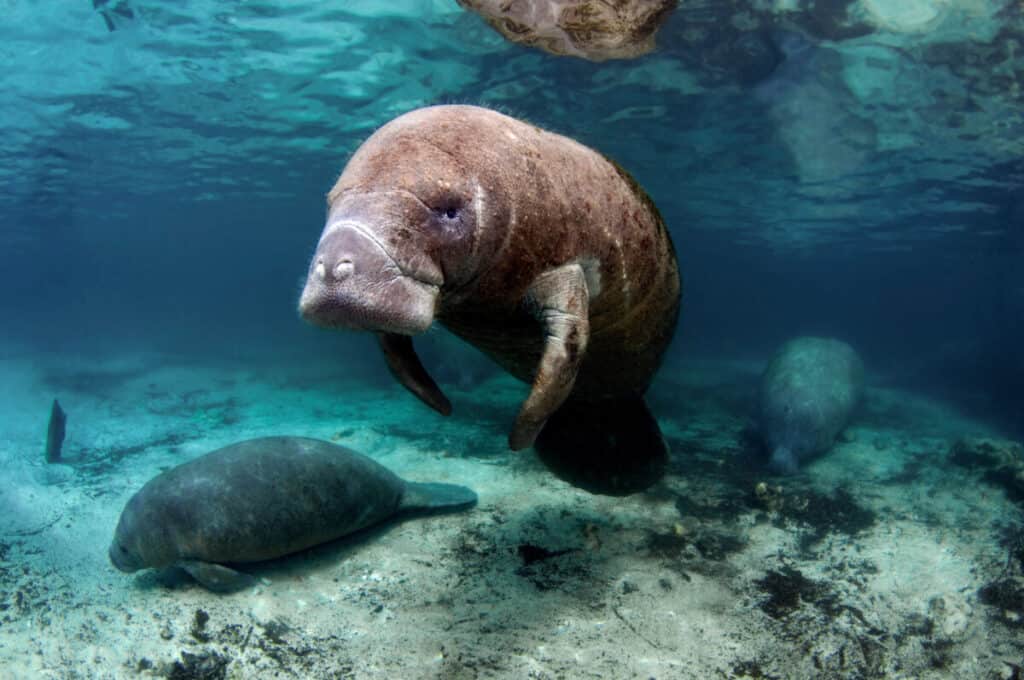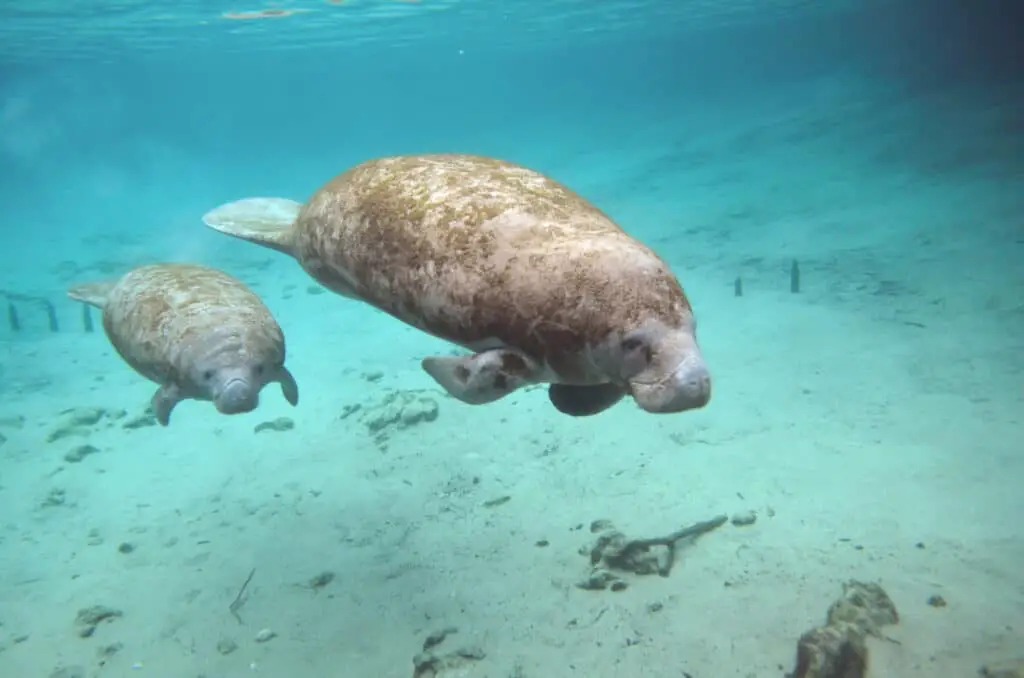The manatee, also known as sea cow, is an aquatic mammal found in warm waters throughout the world. These gentle giants are herbivores and can reach up to 13 feet in length and weigh around 1,200 pounds.
Manatees have a unique appearance with their large flippers, rounded bodies, and wrinkled skin that helps them regulate body temperature.
Manatees belong to the Sirenia order which includes dugongs and sea cows. They are classified into three species: West Indian manatee, Amazonian manatee, and African manatee.
The West Indian manatee is further divided into two subspecies namely Florida manatee and Antillean manatee.
Despite being protected by law in many countries due to habitat destruction, hunting for meat, boat collisions and pollution continue to threaten the survival of these peaceful creatures.
This article aims to provide an overview of the physical characteristics, behavior patterns, distribution range along with threats faced by this fascinating marine mammal – the manatee.

Physical Characteristics Of Manatees
The manatee, also known as sea cow, is a marine mammal that belongs to the order Sirenia. They are found in shallow coastal waters and rivers of tropical regions such as West Africa, North America, South America, and the Caribbean. These gentle giants can grow up to 4 meters long and weigh over 600 kg. Interestingly, they spend most of their life underwater but need to come to the surface every 3-5 minutes for air.
Manatees have a unique set of physical characteristics that enable them to survive in their habitat preferences. Their bodies are covered with thick skin that protects them from rough surfaces and parasites. Moreover, their flippers help them maneuver through water while their paddle-like tail propels them forward.
In terms of feeding habits, manatees are herbivores who feed on aquatic plants like seagrasses and algae. They use their prehensile upper lip to grasp food items and tear it apart using grinding teeth located at the back of their mouths.
Due to these specialized adaptations, manatees play a crucial role in maintaining the balance of ecosystems where they reside without competing with other animals’ resources.
Sirenians in Peril: Why We Must Preserve These Unique Creatures
Behavior Patterns Of Manatees
Manatees’ physical characteristics have been discussed in the previous section, which includes their size and shape.
In this section, we will delve into their behavior patterns.
Manatees are herbivorous mammals that feed on seagrasses and aquatic vegetation.
They are known for being slow swimmers but can cover long distances during feeding periods.
Feeding habits of manatees vary depending on the season and location.
During winter months when food sources are scarce, they may travel to warmer waters where there is an abundance of vegetation.
Manatees use their flippers to grasp onto plants while using their muscular lips to pull them up from the bottom of the water.
Social interactions among manatees usually occur during mating seasons or when searching for a mate.
Although they do not form permanent social bonds like other animals, they do exhibit some level of communication through vocalizations such as chirps, whistles, and grunts.
Dugongs’ Predators Exposed: Unveiling the Threats
Distribution Range Of Manatees
Like the gentle flow of a river, manatees move through their distribution range with grace and ease. These slow-moving creatures can be found in warm coastal waters and rivers throughout the Americas, from as far north as Virginia to as south as Brazil.
Their habitat preferences include shallow waterways with abundant vegetation, such as seagrass beds, mangrove swamps, and estuaries.
Manatees are known for their migration patterns that follow seasonal changes in water temperature and food availability. In Florida, for example, manatees often migrate towards natural springs during colder months where they can find warmer water temperatures. During summer months when surface temperatures rise above 80°F (27°C), manatees may travel further out into open water or seek refuge in shaded areas of deep channels.
Despite these predictable movements, human activities such as boat traffic and habitat loss continue to threaten the survival of this beloved marine mammal species.
Manatees and Their Predators: Revealing the Threats
Classification Of Manatees
Manatees belong to the order Sirenia, which also includes dugongs and sea cows. There are three extant species of manatees: the West Indian, Amazonian, and African. These herbivorous marine mammals can be found in warm coastal waters, rivers, estuaries, and lagoons.
Habitat preferences vary among different manatee populations. The West Indian manatee is commonly found in shallow, slow-moving rivers and protected bays along the coasts of Florida, Mexico, Central America, northern South America, Caribbean islands, and northeastern Brazil.
The Amazonian manatee inhabits freshwater habitats within the Amazon Basin including river systems that extend into Colombia, Peru, Ecuador, Bolivia, Venezuela and Brazil.
Meanwhile, the African manatee occurs in both saltwater (coastal) and freshwater environments of western Africa from Senegal to Angola.
Evolutionary history shows that sirenians have been around for at least 50 million years with fossil records dating back to the Eocene epoch. Manatees evolved from a common ancestor with elephants about 60 million years ago during their adaptation to an aquatic lifestyle through natural selection processes such as elongated limbs evolving into flippers or paddle-like appendages for swimming purposes.
List of Habitat Preferences Among Different Manatee Populations
- West Indian manatee – Shallow slow-moving rivers & protected bays
- Amazonian manatee – Freshwater habitats within the Amazon Basin
- African manatee – Both saltwater (coastal) & freshwater environments of western Africa
- All three species can be found in warm coastal waters; however specific habitat preferences may vary depending on population location
Family Trichechidae: Exploring the Fascinating Realm of Manatees
Threats To The Survival Of Manatees
Having established the classification of manatees, it is essential to examine the threats that these gentle creatures face. Habitat loss and human interaction are two significant factors that endanger the survival of manatees.
Habitat loss has been a primary concern for manatees over the years. The destruction of seagrass beds due to pollution, coastal developments, and dredging activities disrupts their feeding and breeding grounds. Additionally, changes in water temperature caused by climate change negatively affect their habitat as they require warm waters to regulate their body temperatures.
As a result, habitat fragmentation forces them to move into areas where they are exposed to further danger from boats and other human activities.
Human interactions also pose a major threat to the survival of manatees. Boating accidents remain one of the leading causes of injury or death among manatees. Manatees often surface slowly, making them vulnerable targets for boat propellers resulting in collisions which can cause severe injuries or even fatalities. Other forms of human interference such as accidental entanglement with fishing gear have led to an increase in mortality rates amongst manatee populations.
It is therefore crucial to develop measures aimed at reducing human impact on these endangered species through policy implementation and increased public awareness campaigns.
Diving into the Sensory World of Dugongs: How Good Are Their Senses?
Conservation Efforts For Manatees
Conservation efforts for manatees have been put in place to ensure their survival.
Ecotourism impact has become a key factor in the conservation of manatees. This is because ecotourism activities bring about increased awareness and concern among people about the need to protect these animals and their habitats. However, it is important that such eco-tourism activities are carried out sustainably so as not to cause harm to the manatee populations or their habitat.
Government policies also play an important role in conserving manatees. For instance, many countries with significant populations of manatees have enacted legislation aimed at protecting these marine mammals from human activities such as hunting, poaching and habitat destruction.
In addition, some governments have designated protected areas where manatees can live without fear of disturbance. These actions by governments help promote the long-term survival of the species while ensuring they continue to thrive in natural environments free from human interference.

Conclusion
Manatees, also known as sea cows, are fascinating marine mammals that can be found in warm coastal waters and rivers. They possess unique physical characteristics such as their large size, wrinkled skin, and paddle-shaped flippers which make them well adapted for life in water.
The behavior patterns of manatees include a slow pace of movement and feeding on aquatic vegetation throughout the day. These gentle creatures travel alone or in small groups and communicate through chirps, whistles, and squeaks.
Unfortunately, manatees are threatened by human activities such as boat collisions, pollution, habitat loss, and hunting. To address these issues, conservation efforts have been implemented to protect these animals from extinction.
These efforts include creating safe zones for manatees to swim freely without interference from boats and educating the public about the importance of preserving this species. However, despite these initiatives, more needs to be done to ensure that manatees continue to thrive in their natural habitats.
In conclusion, manatees not only serve an ecological purpose but they also add beauty to our oceans and rivers with their peaceful nature. It is important for us all to recognize the significance of protecting these magnificent creatures so that future generations can appreciate them too.
We must work towards conserving manatee populations by reducing human-induced threats while promoting positive attitudes towards coexisting with wildlife. By doing so we can help safeguard the future existence of one of nature’s most marvelous creations – the Manatee!

